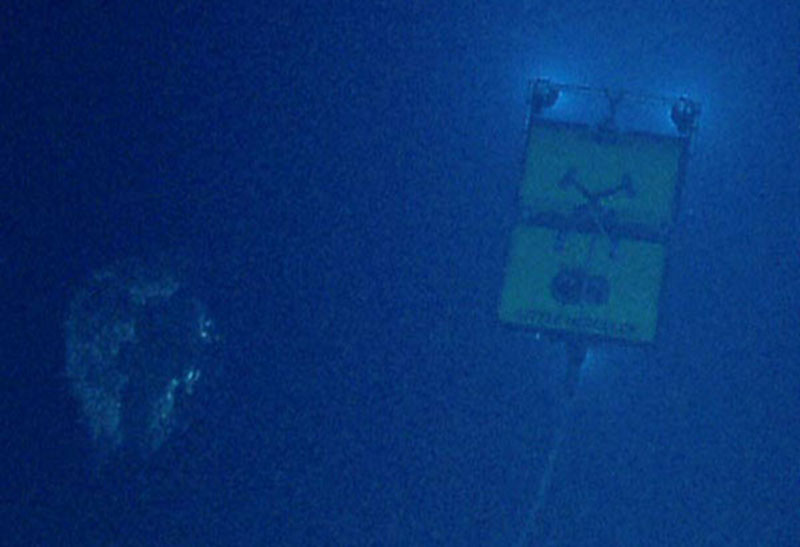
By Mike Vecchione, NOAA/NMFS National Systematics Laboratory, National Museum of Natural History
March 26, 2012

View from Seirios of Little Hercules searching in midwater. Between the ROV and the camera is a large web-like mucus feeding structure. Image courtesy of the NOAA Office of Ocean Exploration and Research, Gulf of Mexico Expedition 2012. Download image (jpg, 48 KB).
Between the deep-sea bottom and the sunlit surface waters are the open waters of the deep pelagic environment. This huge volume (over a billion – yes billion with a “b” – cubic kilometers) makes up most of the living space on Earth, but is the least explored environment for complex organisms on our planet.
Video footage captured by the Little Hercules ROV and camera platform during the March 27 ROV dive from NOAA Ship Okeanos Explorer during the Gulf of Mexico Expedition 2012. Video courtesy of the NOAA Office of Ocean Exploration and Research, Gulf of Mexico Expedition 2012. Download (mp4, 100.8 MB).
The deep midwater environment includes both the mesopelagic or “Twilight Zone” (between 200-1,000 meters depth) where dim sunlight can penetrate during mid-day, and the permanently dark bathypelagic (depths greater than 1,000 meters) where the sun never shines. Searching this dynamic three-dimensional expanse is much more difficult than searching an interface like the sea bottom. Remotely operatated vehicles (ROVs) can contribute important pelagic observations, but methods must be worked out to use the Little Hercules/Seirios two-body system on the Okeanos Explorer for such work. We have had an opportunity to develop such methods on Leg 2 of the 2012 Gulf of Mexico cruise.
We chose the lower DeSoto Canyon to work on these methods because that area provides an opportunity for potentially important observations while developing the methods. Such canyon areas are preferred feeding grounds for sperm whales. A population of sperm whales resident in the Gulf of Mexico is known to spend a lot of time feeding in the DeSoto Canyon. Recent fishing with large midwater trawl nets has shown that this area supports robust numbers of a variety of large squids and other species that are potential prey for the whales, but trawling cannot provide the detailed information on vertical distribution and behavior that could be observed with an ROV.
A test dive was conducted during Leg 2 while the ROV descended through potential sperm-whale feeding habitat on its way to other objectives on the bottom. During the time devoted to determining midwater capabilities and developing methods, we searched depths of 600-1,200 meters because these are depths at which sperm whales are known to feed.
The ROV was driven for 10 minutes along horizontal transects at 100 meter-depth intervals. This was actually quite tricky because Little Hercules had to lead a parade consisting of the ROV, the Seirios camera platform, and the ship being steered backwards using its dynamic-positioning system. The crew managed to improve methods substantially between the beginning and the end of these observations. More good news was that having cameras on both Little Hercules and Seirios doubled the volume that could be observed during the transect. Although we did not get a clear look at animals known to be whale food, we did see fishes, shrimps, large drifting jelly animals, and mucus feeding structures.
Now that we have a better idea of how to do it, we hope to devote more time later in the cruise to searching the deep, dark, unexplored midwater environment.